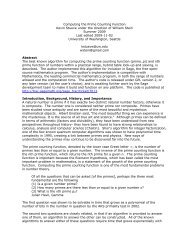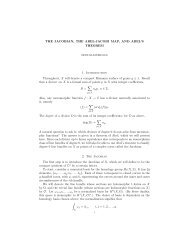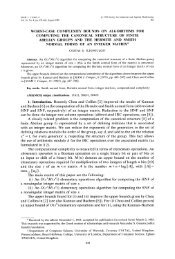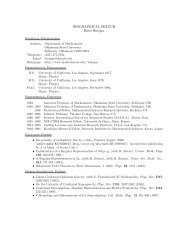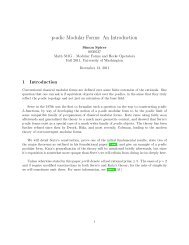Introductory Differential Equations using Sage - William Stein
Introductory Differential Equations using Sage - William Stein
Introductory Differential Equations using Sage - William Stein
You also want an ePaper? Increase the reach of your titles
YUMPU automatically turns print PDFs into web optimized ePapers that Google loves.
1.6. NUMERICAL SOLUTIONS - EULER’S METHOD AND IMPROVED EULER’S METHOD39<br />
<strong>Sage</strong><br />
sage: x,y=PolynomialRing(QQ,2,"xy").gens()<br />
sage: eulers_method(5*x+y-5,1,1,1/3,2)<br />
x y h*f(x,y)<br />
1 1 1/3<br />
4/3 4/3 1<br />
5/3 7/3 17/9<br />
2 38/9 83/27<br />
sage: eulers_method(5*x+y-5,0,1,1/2,1,method="none")<br />
[[0, 1], [1/2, -1], [1, -11/4], [3/2, -33/8]]<br />
sage: pts = eulers_method(5*x+y-5,0,1,1/2,1,method="none")<br />
sage: P = list_plot(pts)<br />
sage: show(P)<br />
sage: P = line(pts)<br />
sage: show(P)<br />
sage: P1 = list_plot(pts)<br />
sage: P2 = line(pts)<br />
sage: show(P1+P2)<br />
The plot is given in Figure 1.13.<br />
Figure 1.13: Euler’s method with h = 1/2 for x ′ + x = 1, x(0) = 2.<br />
1.6.2 Improved Euler’s method<br />
Geometric idea: The basic idea can be easily expressed in geometric terms. As in Euler’s<br />
method, we know the solution must go through the point (a,c) and we know its slope there<br />
is m = f(a,c). If we went out one step <strong>using</strong> the tangent line approximation to the solution<br />
curve, the approximate slope to the tangent line at x = a + h,y = c + h · f(a,c) would be





